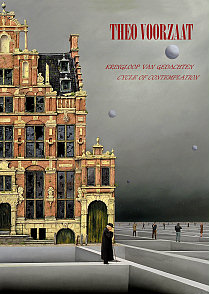Catalogue 2006
Theo Voorzaat

|
Cycle of Contemplation |
|
The majority of Theo Voorzaat's paintings feature buildings which, singular as they may be, have to put up with a dilapidated portrayal that fits in with the artist's views. Voorzaat considers mankind as a mass of terribly busy individuals who have to establish time and again that things have not turned out the way they had expected. In doing so he appeals to the nostalgia of the "good old days" sentiment - for which the decaying structures are the perfect foil - and to technology as the source of hope and failure at the same time. Man never gives up, not even in Voorzaat's paintings. Man keeps making efforts - and quite heroically so - to make things better for himself, and in doing so keeps pulling the wool over his own eyes. Much if not all of what man comes up with results in disaster and chaos, disenchantment and incomprehension, and yet eternal hope keeps him going. One of Voorzaat's particular talents is his balancing of the negative and the positive using a variety of symbolised fruits of progress bathing in different kinds of light, to create room for hope of a change for the better. It is this hopefulness which is always beckoning in Voorzaat's paintings, wandering as a pacifying light between the future remnants of our civilisation.
Which has been the fate which has now befallen the "House with the Heads". The very history of this 17th century Amsterdam canal property is eerily in sync with Voorzaat's subject matter. The House with the Heads has witnessed people living and working, speaking and thinking, suffering and laughing within the confines of its walls. At one time it was the residence of an arms dealer; at another, the Czech-born scientist Comenius called it home. In the course of the 19th century the property was taken into use as a secondary school, succeeded at a later stage by the Amsterdam music academy. Its most recent occupant was the municipal agency for the preservation of monuments and historic buildings. The walls of the property have heard in all kinds of ways how things sounded, or should have sounded. Would we be any the wiser if its bricks could talk? Imagine a new invention making it possible to hook up a mobile phone to a brick, for us to enhance the quality of life thanks to the body of wisdom having been gleaned and lost over the centuries … Then again, according to Voorzaat's paint brush this would cause us to get entangled in all kinds of inextricable incongruities, to stir up even greater chaos rather than making things better. One could characterise Voorzaat's position in the landscape of the visual arts as that of a down-to-earth prophet. A surrealist he is not, nor is social commitment his priority, albeit that anyone who involves himself in the ways of the world will sooner or later find himself grappling with dilemmas of good versus evil. As a painter, Voorzaat in a manner of speaking is the embodiment of a form of survival that is kept afloat owing to the realisation that although as an individual, there's an awful lot to put up with and little power of change, it is nevertheless better to look on the bright side. Things don't get much more contemporary, yet of all time. Introduce a notion of the divine in this context and you can practically see the few people in his paintings think "Beware what you are bargaining for". Voorzaat is not one to pass judgment in this respect. It is not in his nature to point his troubled fellow men in the right direction. For centuries mankind has felt comfortable in varying circumstances for as long as it lasted, for the scenery, the players and the texts have always been subject to change. This is why a painting such as "Day Out to Earth II" has so much in common with our own comings and goings. Does the thought of being one of the day trippers on a day out to what is left of the planet horrify you? A walk through the ancient centre of Amsterdam is hardly any different, albeit that it is available at closer range. After all, the House with the Heads, having accommodated the municipal agency for the preservation of monuments and historic buildings for several decades, is now looking forward to housing an extensive library of books and manuscripts that encompass an age-long quest for divine revelation and as such, represent a spiritual version of the previous occupant. Talk about making sense … doesn't it almost seem as if houses too can be hopeful? Koen Nieuwendijk |
TOP